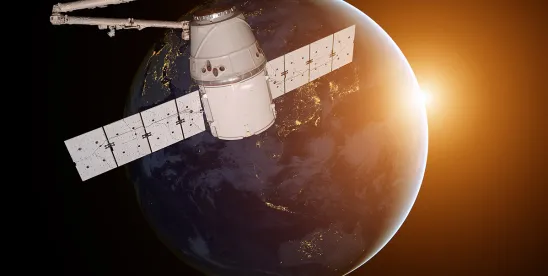You have always dreamed of going to space. All of us have at some point or another. And the only thing standing between you and that dream were overly-restrictive commodity and technology export licensing requirements on certain space items to specified countries! (well, that, and gravity, and the fact that you are not a billionaire[1], and maybe a few other things).
But still! One of the obstacles to your dream of space tourism has been now been lowered, as the U.S. Department of Commerce has introduced a rule outlining the new Commercial Space Activity (CSA) license exception. While the license exception will not lift licensing requirements from all commercial space activity, it will provide for the export, without a license, of certain space commodities and technology related to space tourism, space research missions, and U.S. government space agency programs.
1. The October 2024 Space Rules
On October 17, 2024, U.S. agencies overseeing exports in the space industry[2] issued four new regulatory notices, each of which should reduce compliance burdens and potential confusion that space and satellite companies have faced in the past (the October 2024 Space Rules). All of the regulations appear to be aimed at modernizing U.S. export regulations and keeping the U.S. commercial space industry competitive globally, as follows:
- A rule removing or exempting items from defense export controls, including, among others:
- Decontrolling spacecraft that can dock with commercial space stations, as well as spacecraft with autonomous collision avoidance
- Providing limited exemptions to items for certain space agency programs, space tourism, and space fundamental research
- A rule reducing and clarifying commercial controls on certain items, including, among others:
- Reducing controls on Export Control Classification Number (ECCN) 9A515.x, a catch-all for space-related parts, components, and accessories
- Clarifying rules on spacecraft and launch vehicle export controls
- Clarifying controls on vehicles launched in international waters
- A rule eliminating the export license requirements for certain spacecraft to Australia, Canada, and the United Kingdom.
- A rule which is the subject of this blog post, adding a new export License Exception for Commercial Space Activities (CSA).
We welcome you to read each rule through the links provided above.
Below, please find our overview of the fourth and last October 2024 Space Rule, wherein BIS proposes a new License Exception CSA, additional clarifications, and new ECCNs. This proposed rule was published on October 23, 2024.
2. New License Exception CSA
BIS’s proposed rule introduces a new license exception CSA which encompasses two types of authorizations: one that permits the export, reexport, and transfer (in-country) of items for certain ‘official space agency programs’, and another for manned spacecraft (including its parts, components, accessories, and attachments) used in space tourism and research missions. License Exception CSA will not be available under certain circumstances.
The official space agency programs currently include:
- NASA’s Lunar Gateway;
- NASA’s Mars Sample Return (a program that entails multiple spacecraft);
- Nancy Grace Roman Telescope;
- The Orion spacecraft;
- Commercial Low Earth Orbit Development program; and
- Habitable Worlds Observatory.
In order to utilize License Exception CSA for official space agency programs, the items must fall strictly within the scope of an official space agency program.
Given the rise of government space-related projects and their cross-border collaboration, this license exception will ease compliance burdens for the space industry. For example, License Exception CSA could be used to export a 9A515.g component to a space contractor in France that is producing a higher level assembly intended for use in NASA’s Lunar Gateway program.
In order to utilize License Exception CSA for space tourism and research, the following conditions must be met:
- The spacecraft must be limited to suborbital trajectories;
- The purpose of the activity must be limited to either space tourism or supporting “fundamental research;”
- The activity must not transfer registration, control, or ownership of the spacecraft to a foreign person; and
- The spacecraft’s destinations, including planned diverts and contingencies, must be approved by the Federal Aviation Administration or its foreign equivalent in all countries, and must not include any destinations listed in Country Groups D:5 or E.
We expect this authorization to be welcome news to the space industry. Space tourism and research companies will be able to export certain items quickly by utilizing License Exception CSA, rather than having to go through a months long license application process. This will save time, money, and aid the U.S. space industry in remaining globally competitive.
3. Clarifications and New ECCNs
Besides the new license exception, BIS’s proposed rule also includes additional clarifications and new ECCNs.
The proposed rule clarifies that spacecraft providing space-based logistics, assembly, or servicing of another spacecraft under ECCN 9A515.a are those that perform remote proximity on-orbit services to other spacecraft (e.g., docking, delivery, refueling, or servicing), provide life sustaining operations (e.g, space stations, space hotels, outposts, or laboratories), or capture, collect, and remove space debris. This is a much welcome clarification and in line with DDTC’s focus on surveillance and non-cooperative docking spacecraft (which we describe previously in part 1).
We also note that the proposed rule also expands the control parameter under 9A515.g.1 for space qualified optics.
Further proposed ECCNs and subparagraphs some of which are transferred from the United States Munitions List (USML) include the following:
| Proposed ECCNs and subparagraphs | Description |
| 9A515.i | Electric (Plasma/Ion) thrusters and their associated power control systems operating at in input power of less than 20kW and having an individual thrust of at least 400 milli-Newtons, but not also having a specific impulse better than 1,900 seconds, which the Department of State has proposed moving from the USML to the CCL. |
| 9A515.j | Moment gyroscopes (CMG) “specially designed” for spacecraft that provide an angular momentum of less than 2.0 (N m sec) or provide a torque of less than Newton meters (N m), which the Department of State has proposed moving from the USML to the CCL. |
| 9A515.k | Hold-down or satellite release mechanisms (i.e., clampbands, adapters, dispensers, or motorized lightbands) not described in USML Category IV(e)(5), excluding those for 1U CubeSats or less. |
| 9C515 | Materials, coatings, and treatments aimed at minimizing the detectability (radar, optical, ultraviolet, and infrared signatures) of spacecraft, such as blankets, films, tapes, and paints meeting certain thresholds. ECCN 9C515 would be controlled for NS1, RS1, and AT1 reasons. License Exception Strategic Trade Authorization could potentially be available for Country Group A:5. |
| 9D515.c | Space Situational Awareness (SSA) analysis software used to model, simulate, optimize, or perform operations involving spacecraft maneuvers, trajectory planning, or debris tracking. |
| 9E515.g | Technology required for the development, production, operation, failure analysis or anomaly resolution of commodities controlled by ECCN 9A515.i. |
| 9E515.h | Technology required for the development, production, operation, failure analysis or anomaly resolution of commodities controlled by ECCN 9A515.j. |
| 9E515.i | Technology required for the development, production, operation, failure analysis or anomaly resolution of commodities controlled by ECCN 9A515.k. |
The transfer of UMSL categories to the Commerce Control List may represent cost savings to the space industry as compliance with EAR controls typically requires fewer company resources than compliance with DDTC’s ITAR controls.
4. Status of the Rules
DDTC’s proposed rule largely revises the ITAR USML Categories IV and XV and was published in the Federal Register on October 23, 2024. Comments for the proposed rule must be received by DDTC no later than Friday, November 22, 2024.
BIS published revisions and additions to its space-related export controls which are detailed in a an IFR, a final rule, and a proposed rule. The IFR and final rule are effective October 23, 2024. Comments for the IFR and proposed rule must be received by BIS no later than Friday, November 22, 2024.
5. More to Follow
This is the last blog post of our four-part series.
We continue to monitor these developments and expect to see additional tweaks and guidance in the future. We will, of course, keep our readers updated.
FOOTNOTES
[1] Yet!
[2] The U.S. Department of State Directorate of Defense Trade Controls (DDTC) which promulgates and enforces the International Traffic in Arms Regulations (ITAR), and the U.S. Department of Commerce Bureau of Industry and Security (BIS) which promulgates and enforces the Export Administration Regulations (EAR).
Find the previous articles in this series here: Part I, Part II, and Part III





 />i
/>i

